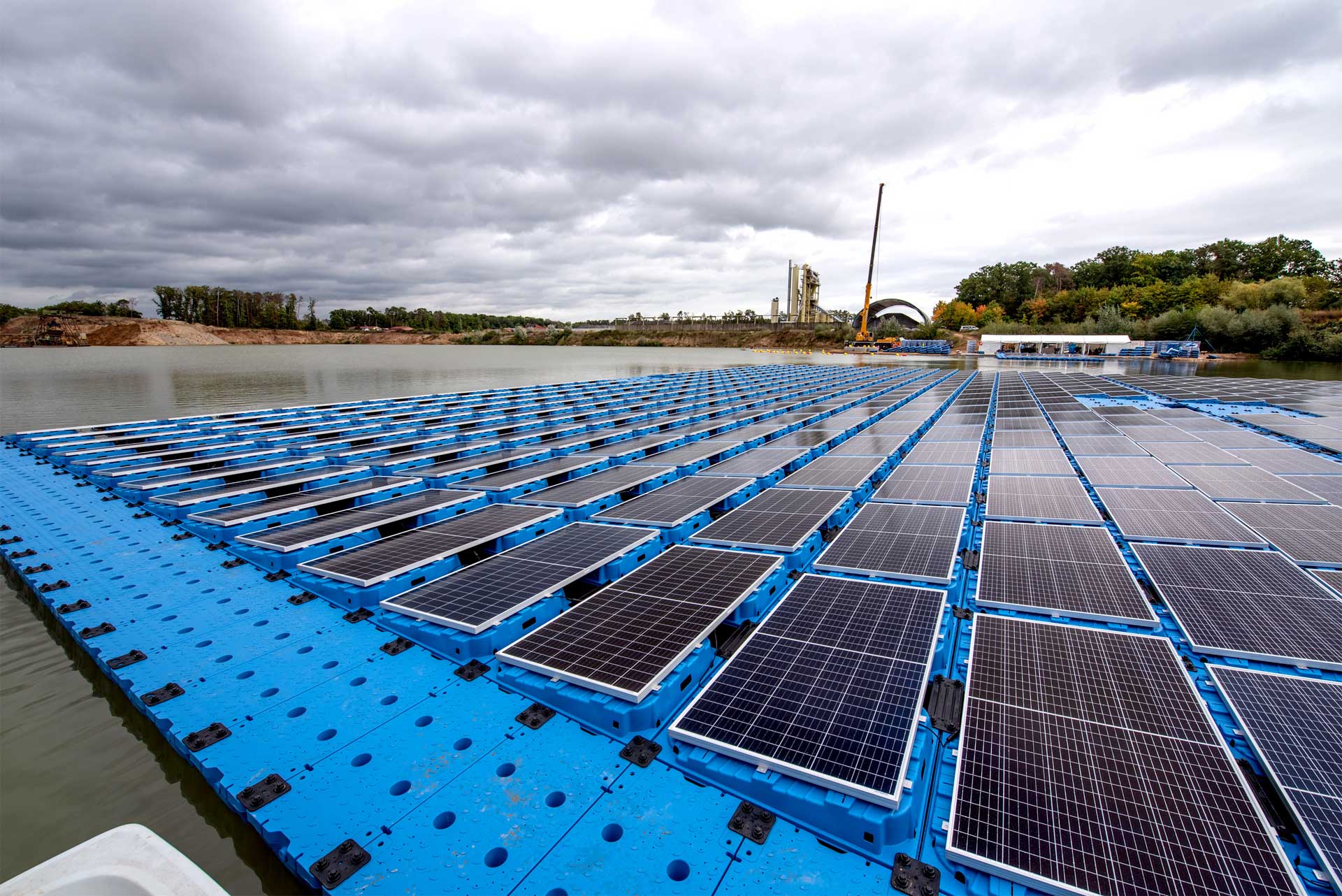Electricity and water mix perfectly
At many quarries, raw material extraction creates large lakes. Although there is potential for interesting after-use and habitat creation on the shores of the lakes, use of the water surface is often limited. Two recent projects at Heidelberg Materials quarry sites demonstrate the potential of using these lake surfaces to accommodate floating solar plants for electricity generation.
Photovoltaic power generation is climate friendly and sustainable, but it requires large expanses of unused areas, which can typically be found in former industrial locations or low-grade agricultural land. With solar panels floating on water, however, quarry lakes also become ideal locations. Heidelberg Materials has taken up this idea and installed two floating solar plants, one at a reclaimed limestone quarry at Saint Maurice-la-Clouère in the Nouvelle Aquitaine region of Western France, and the second on the lake of the Dettelbach gravel plant in Bavaria, Germany.
The floating solar plant at Saint Maurice-la-Clouère is an unprecedented reclamation project for the region, which was commissioned on 6 October 2020. While the original after-use plan of the quarry lake permitted recreational activities and fishing, GSM proposed installing a solar floating plant instead. The company worked closely with the Saint Maurice-la-Clouère city council and local stakeholders to change the permit to allow construction of a 2.7 MW floating photovoltaic plant.

Heidelberg Materials
“The city council was very supportive during the permitting process,” said Sylvie Berhault. “It is difficult for a city council to formally decide in advance on the future use of a site given the long duration of quarry activity over as much as 30 years. Future land use should always be continually reassessed in consideration of local needs at the end of quarrying.”
SERGIES (Energies Vienne Group), a regional renewable energy producer, installed and operates the new solar plant. The 8,000 locally produced floating solar panels, installed on 4.5 hectares of water, provide financial benefits for the municipality and an innovative contribution to the new regional climate and energy plan. With an annual production of 3.3 GWh of green electricity, the plant will supply around 1,700 residents for a period of at least 20 years – eliminating 1,000 tonnes of CO₂ emissions per year.
Floating solar power plant in Germany
A similar approach was taken at the still operating quarry in Dettelbach, Germany, where floating photovoltaic panels currently generate 0.7 GWh of electricity per year. Designed and installed by the power company Climagy on behalf of Heidelberg Materials' German aggregates company, the solar plant consists of 4,000 floating panels bolted together and anchored in the lake with concrete foundations. 200 tonnes of concrete were used for the foundations, produced by the company's own concrete plant on site.
The solar plant primarily supplies electricity to the gravel processing plant. Such sustainable and climate-neutral power generation is ideal for the Dettelbach plant, as much of its equipment – such as the conveyor belts – are powered by electricity. The solar plant uses the existing power line infrastructure, and surplus power generated on weekends is fed back into the public grid.

Heidelberg Materials
The photovoltaic power supply fits the load profile of the plant almost perfectly: The Dettelbach plant runs only during the day – photovoltaic generation requires daylight! The plant typically runs at full capacity in summer, when demand for gravel is highest and electricity generation at its peak. During the winter, when electricity generating potential is lower, construction activity is also reduced and the gravel plant runs at a lower capacity.
The solar plant at Dettelbach saves around 280 tonnes of CO₂ per year, amounting to 7,000 tonnes of CO₂ over its 25-year lifetime. In addition, by installing the solar plant on water, the surrounding land is available for other uses. Another benefit comes from the shading of the water by the panels. They keep the water cooler in summer, which reduces the growth of algae and thus helps maintain water quality.
Both projects demonstrate impressively that – when working as a proactive partner with the local authorities and stakeholders – quarry activities can be integrated into local planning frameworks to create opportunities for the company, society and the environment. These projects are a blueprint for the whole of Heidelberg Materials Group to support sustainability and deliver the greatest possible benefits from land and water use.

Dettelbach solar plant. The solar plant at Dettelbach saves around 280 tonnes of CO₂ per year.
Heidelberg Materials

Saint Maurice-la-Clouère. The floating solar plant at Saint Maurice-la-Clouère was commissioned on 6 October 2020.
Heidelberg Materials

Dettelbach solar plant . The Dettelbach solar plant consists of 4,000 floating panels bolted together and anchored with concrete foundations.
Heidelberg Materials

Dettelbach solar plant. The solar plant at Dettelbach saves around 280 tonnes of CO₂ per year.
Heidelberg Materials

Saint Maurice-la-Clouère. The floating solar plant at Saint Maurice-la-Clouère was commissioned on 6 October 2020.
Heidelberg Materials

Dettelbach solar plant . The Dettelbach solar plant consists of 4,000 floating panels bolted together and anchored with concrete foundations.
Heidelberg Materials
